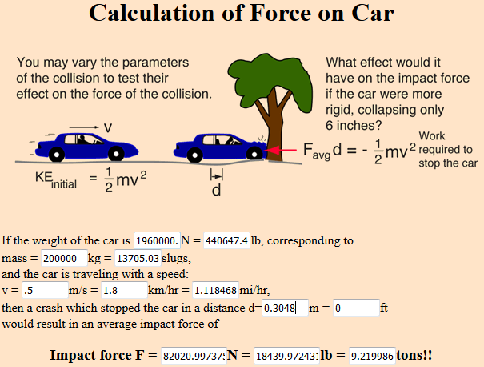TAGGED: ansys-workbench, autodyn
-
-
January 10, 2022 at 6:29 am
pxl
SubscriberHi, i am new to Ansys, specifically to dynamic simulation. I am trying to get the basic of dynamic simulation, before doing any real simulation. Thus i take a crash simulation to see if i can get anything right.
For easier reference to all, i try to use example in this site, but replace with a simple model for simulation (cube and plate). http://hyperphysics.phy-astr.gsu.edu/hbase/carcr.html#cc1
Thus the idea is. i took a 200mT mass to hit a plate to see the stress distribution. given from 1/2mv^2, this gives 25kJ at 0.5m/s KE. The end time is less than 1 sec since i have 0 distance from the plate to reduce the simulation time for the cube to travel. From this, i get to see the stress distribution and energy reduction upon impact.
However the question is, from the site above, the impact force, gives only 82,020 N, while in the simulation gives me more than 1+e8 N.
The contact is friction less since from the hand calculation, it does not take f coefficient into consideration, i only take one single axis (Z) to observe the force, which in this case i took reaction force to compare.
Am i doing something wrong? Please go easy on me.
January 10, 2022 at 7:54 ampxl
SubscriberOh and i modified the density of the moving object to get the said mass so that i wont have to model a large cube for it
January 10, 2022 at 6:25 pmChris Quan
Ansys EmployeeHow did you get the impact force of 82 kN? Were you assuming that the impact force is a constant during the entire impact event?
In fact the impact force is usually not a constant. It changes during the impact event.
If you have time history of the predicted impact force, you can integrate it with time to get the force impulse. Then you can compare it with your hand calculation or experimental measurements to verify the numerical results.
For this magnitude of the impact force, both cube and the plate could develop plastic deformation if they are ductile materials or damages if they are brittle materials. Thus, make sure nonlinear material property is taken into account in your numerical models.
January 11, 2022 at 1:31 ampxl
Subscriber
Thank you for replying.
What i mean in the first post is that to replicate what that this figure tells.
 Yes, but i thought the highest force given in the reaction graph would be only 82kN. For the material, i am using both default steel material. B going what you've said, does that means my assumption in the picture is wrong?
Yes, but i thought the highest force given in the reaction graph would be only 82kN. For the material, i am using both default steel material. B going what you've said, does that means my assumption in the picture is wrong?
January 13, 2022 at 10:24 pmChris Quan
Ansys EmployeeIf you look at the picture in your post carefully, it says "F_avg". It is the average Force, not the highest force.
The manual calculation also assumed that the car stops at 6 inches displacement. How far has the cube travelled in your analysis?
If the travel distance is less than 6 inches, it means that the predicted force on the cube should be higher than the force stopping the car in 6 inches distance. Higher force stops the car sooner.
Viewing 4 reply threads- The topic ‘Collision / Crash Simulation’ is closed to new replies.
Ansys Innovation SpaceTrending discussionsTop Contributors-
2793
-
965
-
851
-
599
-
591
Top Rated Tags© 2025 Copyright ANSYS, Inc. All rights reserved.
Ansys does not support the usage of unauthorized Ansys software. Please visit www.ansys.com to obtain an official distribution.
-









